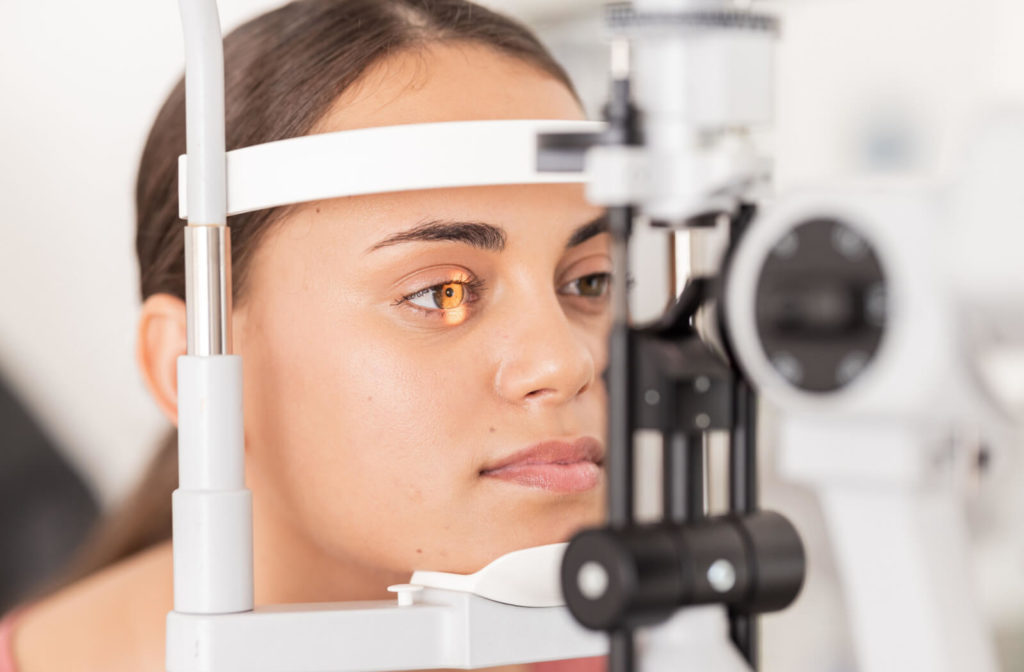Blepharitis is a common eye condition that can cause symptoms such as eye irritation, redness, and inflammation around the eyelids—it can also lead to other symptoms of dry eye disease. Blepharitis isn’t contagious, so you can’t pass it on to someone else, but you should still seek treatment if you suspect you have it. Blepharitis can be connected with other conditions that are contagious.
If you think you might have blepharitis, you should schedule an eye exam. We can help determine the cause of your symptoms and provide care to support your vision and eye health.
What Is Blepharitis?
Blepharitis is an eye condition that can cause inflammation of your eyelids’ margins. It is often caused by bacteria that build up on the nearby skin, but you can also get it when the glands that produce oil for your tears get clogged—which is a condition known as meibomian gland dysfunction.
What Are the Symptoms of Blepharitis?
Blepharitis shares many symptoms with dry eye disease. They often occur together and can be difficult to tell apart without an eye exam.
Some of the common symptoms of blepharitis include:
- Eye irritation
- Redness
- Inflammation
- Stinging sensations
- Sensitivity to light
- Foamy tears
- Crusty eyelids or eyelashes
Who Is At Risk of Getting Blepharitis?
Blepharitis is a chronic condition that can affect anyone at any age, but it can be more common for people who have:
- Oily skin
- Rosacea
- Allergies
- Dandruff
Can You Transmit Blepharitis?
Blepharitis is not considered contagious—meaning you can’t transmit it from person to person. Most cases of blepharitis are caused by bacterial overgrowth on the eyelid, and the Staphylococcus bacteria that commonly cause blepharitis live on the skin naturally.
While blepharitis itself is not contagious, it can be associated with other conditions that are contagious, such as conjunctivitis.
Conjunctivitis, also known as pink eye, is an eye infection that can cause redness, irritation, and tearing of the eyes. It can be caused by either bacteria or viruses and can be spread through contact with an infected person’s eyes, nose, or mouth.
If you have blepharitis and develop conjunctivitis, you should seek attention from your optometrist and take precautions to prevent spreading the infection to others.
Blepharitis can also cause other eye problems if left untreated, including:
- Styes
- Chalazion
- Chronic red eyes
- Damage to your cornea
- Dry eye
How to Prevent Blepharitis
To prevent blepharitis, it’s essential to practice good eye hygiene. This includes washing your hands frequently and avoiding rubbing or touching your eyes. It’s also recommended that you practice the following healthy eye care habits:
- Clean your eyelids daily
- Keep your eyes clean when you’re symptom-free
- Avoid contact lenses when you have symptoms
- Avoid wearing eye makeup when you have symptoms
If you wear contact lenses, it’s crucial to follow proper cleaning and disinfecting procedures to prevent the buildup of bacteria and other contaminants that can lead to eye infections, like keratitis.
The Connection Between Blepharitis & Dry Eye
While there are different causes of dry eye, blepharitis is considered a common cause.
One of the main functions of the eyelids is to produce oil that keeps the eyes lubricated. When there is inflammation in your eyelids caused by blepharitis, your oil glands may be unable to function properly. As a result, your can eyes become dry, causing symptoms such as burning and redness.
How Can You Manage Blepharitis & Dry Eye?
If you are experiencing blepharitis or dry eye symptoms, it is essential to seek medical attention from your eye doctor. We can diagnose the condition and provide a proper treatment plan.
The treatment for blepharitis usually involves cleaning your eyelids and using warm compresses to reduce inflammation. The specific dry eye treatment we recommend will vary based on your eyes and symptoms but could include using artificial tears, prescription eye drops, or punctal plugs for your tear ducts.
There are also a few lifestyle changes you can make to manage blepharitis and dry eye. Try some of the following habits we recommend:
- Maintain good eyelid hygiene by washing them every day with non-irritating shampoo and warm water or an optometrist-approved eyelid cleanser.
- Avoid touching or rubbing your eyes to prevent further irritation.
- Take frequent breaks when using digital devices to reduce eye strain.

Choose Preventative Eye Care in Ladera Ranch
If you’re showing symptoms of blepharitis, you might not need to worry about being contagious, but you should still visit an eye doctor. With proper treatment and management, we can help support your long-term eye health and comfort.
Our team at Ladera Ranch Optometry can help manage your symptoms before the inflammation caused by blepharitis leads to dry eyes. Schedule your next eye exam for a comprehensive assessment and learn how you can minimize your risk of eye inflammation.



